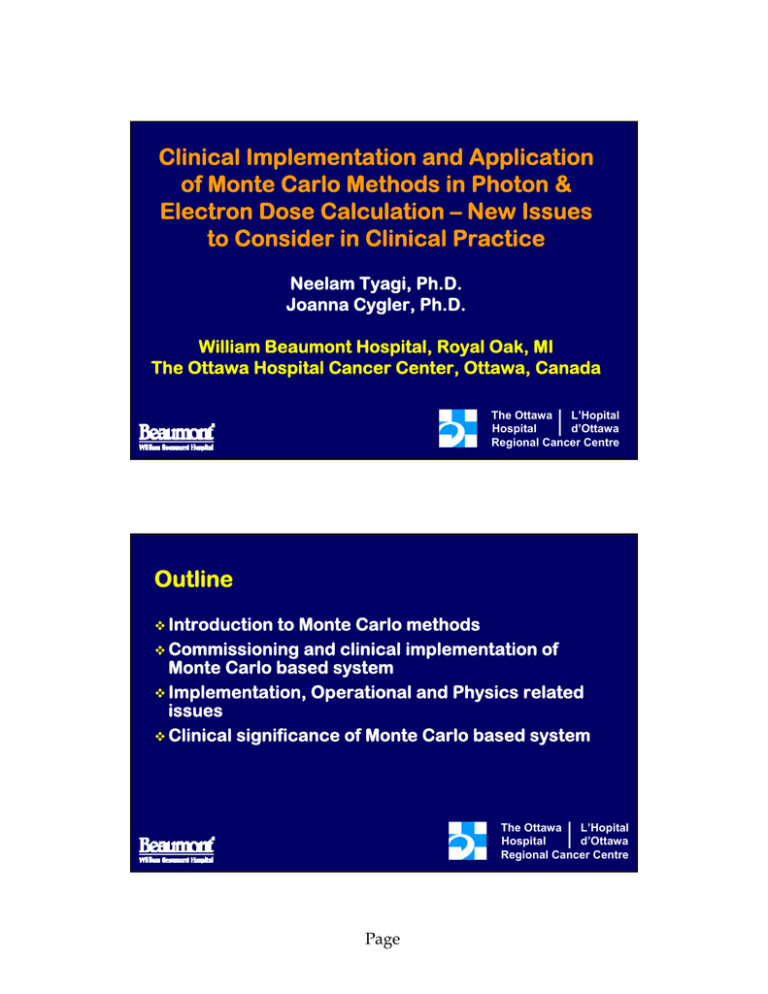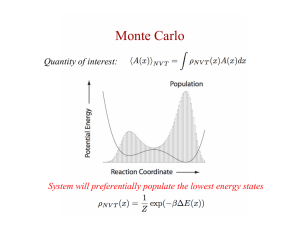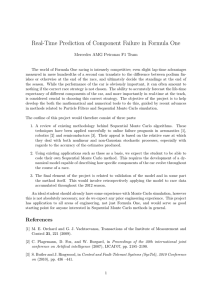Clinical Implementation and Application of Monte Carlo Methods in Photon &
advertisement

Clinical Implementation and Application of Monte Carlo Methods in Photon & Electron Dose Calculation – New Issues to Consider in Clinical Practice Neelam Tyagi, Ph.D. Joanna Cygler, Ph.D. William Beaumont Hospital, Royal Oak, MI The Ottawa Hospital Cancer Center, Ottawa, Canada The Ottawa L’Hopital Hospital d’Ottawa Regional Cancer Centre Outline Introduction to Monte Carlo methods Commissioning and clinical implementation of Monte Carlo based system Implementation, Operational and Physics related issues Clinical significance of Monte Carlo based system The Ottawa L’Hopital Hospital d’Ottawa Regional Cancer Centre Page Photon Monte Carlo Neelam Tyagi, Ph.D. What are Monte Carlo methods? Use probability distributions governing the individual interactions of electrons and photons to simulate the random trajectories of individual particles (Rogers and Bielajew) The process is simulated a number of times to obtain the average quantity Page Monte Carlo transport of radiation photon transport At each interaction Point: • Compton • photo-electric • pair production Interaction probabilities depend on energy, atomic no., density Analog Transport Courtesy I.J. Chetty Photon transport schemes Conventional Photon Tracking • The probability distribution function for photons interacting in a homogeneous medium is given by : P(R) = μe-μR where μ is the mass attenuation coefficient, and R the distance to next collision P’(R) = ∫0 μe-μR => R = -Ln(ξ)/μ R B R R The mean collision distance for a 2 MeV photon in water is ~ 20 cm B Courtesy I.J. Chetty Page Rationale for Monte Carlo dose calculation for photon beams E/O(EPL) Convolution Monte Carlo Ion chamber 100 75 25 Relative dose 50 2x2, 15 MV Lung slab Depth (cm) 0 0 5 10 15 20 25 Courtesy I.J. Chetty Rationale for Monte Carlo dose calculation for photon beams 6 MV Lung 15 MV ρlung= 0.1 g/cc Lung 6 MV ρlung= 0.4 g/cc (Expiration) ρlung= 0.1 g/cc 15 MV ρlung= 0.1 g/cc (Deep Inspiration) Aarup et al, Radiotherapy & Oncology 2009 Page Radiotherapy specific general purpose codes Modeling Radiotherapy beams Optimized for Patient dose calculation only BEAMnrc • Peregrine • VMC/XVMC • DPM • MCDose MCNP GEANT Penelope Commercially available Monte Carlo systems CMS Monaco Algorithm: source model 3D conformal, IMRT (SMLC & DMLC) and VMAT capability No wedges Brainlab iPlan Algorithm: source model 3D conformal, IMRT (SMLC & DMLC) and VMAT capability No wedges Accuray Multiplan ¤ Algorithm, source model ¤ Radiosurgery specific Page Linear accelerator beam modeling Target/Backing Patient independent structures Primary Collimator Flattening Filter Monitor Chamber Scoring Plane #1 Patient dependent structures Secondary Jaws MLC Scoring Plane #2 Phase space - x, y, z (position), u,v,w (direction),energy Linear Accelerator Beam Modeling: Three different approaches -Direct phase space simulation -Virtual source model derived from phase space simulation -Virtual source model derived from measurements Chetty et al AAPM TG-105 Page Virtual Source model in Commercial TPS Commissioning of Monte Carlo based System Data for beam Characterization specified by the vendor (Fraass et al, AAPM TG-53, Das et al, AAPM TG 106) - CAX pdd & profile scans in water: square fields (1x1 to 40x40 cm2), rectangular fields, Diagonal profile scans in water - Output factors in water - Absolute dose in water (linac calibration geometry) Requires two levels of testing: 1. Radiation output from the linear accelerator - Beam model (square fields, output factors, electron contamination) - Beam modifying devices 2. Dose calculation in homogeneous and heterogeneous geometries Page MC validation report: pdds , profiles & output factors PDDs, and Profiles for various field sizes & depths Beam model verification: beam modifiers Page Beam model verification: build-up dose region, oblique incidence 6 MV 18 MV - Choice of measurement detector - Electron contamination model Important for breast & Head and Neck plans 6 MV Panettieri et al, Radiotherapy Oncology, 2009 Dose comparisons in heterogeneous medium Slab inhomogeneity phantom Chetty et al, PMB, 2003 Tyagi et al, PMB, 2006 Page Head & Neck phantom Implementation and operational issues Issues addressed in NCI report Fraass et al, “Summary and recommendations of a National Cancer Institute workshop on issues limiting the clinical use of Monte Carlo dose calculation algorithms for megavoltage external beam radiation therapy”, Med Phys 30 (12), 3206-16 (2003) AAPM Task group 105 Chetty et al, “Issues associated with clinical implementation of Monte Carlo-based treatment planning: Report of the AAPM Task group No 105”, Med Phys (Med. Phys. 34, 2007) AAPM Summer School “Integrating new technologies into the clinic: Monte Carlo and Image-Guided Radiation Therapy”, AAPM Summer school 2006 Commercial Treatment Planning System User Input - Grid/Voxel spacing - Uncertainty based # of Histories - Dose reporting (Dose-to-medium vs. Dose-to-water) Page Effect of statistical uncertainty Sources of statistical uncertainty – ¤ treatment head uncertainty (concern for PS based models, not a concern for measurement based source models) ¤ patient simulation uncertainty Commercial MC systems based on uncertainty based # of histories ( specify % uncertainty per control point or per plan) Effect of statistical uncertainty : IDLs & DVHs 3% 5% Page 0.5 % CT-number to material conversion Conventional TPS algorithm are based on HU-tomaterial density conversion Particle interactions in MC simulations require knowledge of both material density and material composition for appropriate cross-section Medium and/or mass density mis-assignment could result in dose errors of up to 10% for 6MV and 30% for 18 MeV (Verhaegen and Devic, PMB, 2005) CT- number to material conversion Relating CT # to interaction probabilities (Kawrakov et al, Med Phys, 1996) Stoichiometric CT calibration method ( Vanderstraeten et al, PMB 2007) Dual energy CT based material extraction ( Bazalova et al, PMB 2008) Page Dose-to-medium vs. Dose-to-water Dogan et al, PMB 2006 Clinical significance of a Monte Carlo based TPS VMAT planning for kernel based method vs. Monte Carlo in terms of planning QA and planning time Comparison of Kernel based methods vs. Monte Carlo for clinical sites such as breast, head and neck and lung Optimizing prescription based on Monte Carlo dose calculation TCP and NTCP or outcome modeling based on MC dose calculation engine Page Head and Neck Paelinck et al, Radiotherapy & Oncology 2006 Spirodovich et al, Radiotherapy & Oncology 2006 Lung SBRT (Pencil Beam vs. Monte Carlo) Fragoso et al PMB 2010 Page Lung SBRT: Effect of Tumor size & location Peripheral Tumors Central Tumors D95 D99 Van der Voort van Zyp et al Radiotherapy & Oncology 2010 Dmean Optimizing prescription for lung SBRT Peripheral Tumors < 3 cm 3‐5 cm > 5 cm EPL dose = 3x20 Gy 3x16 Gy 3x17 Gy 3x18 Gy Central Tumors (close to esophegus) 3‐5 cm > 5 cm EPL dose = 6x8 Gy 6x7 Gy 6x7.3 Gy Central Tumors 3‐5 cm > 5 cm EPL dose =5x12 Gy 5x10.4 Gy 5x11 Gy Van der Voort van Zyp et al, Radiotherapy & Oncology 2010 Page





